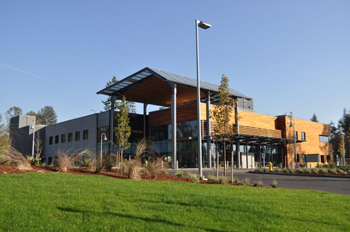 SEATTLE — The LEED program recently created LEED for Health Care (LEED-HC), a specific rating system for health care construction projects, and Group Health Puyallup Medical Center in Seattle is the first to achieve this rating, earning LEED Gold.
SEATTLE — The LEED program recently created LEED for Health Care (LEED-HC), a specific rating system for health care construction projects, and Group Health Puyallup Medical Center in Seattle is the first to achieve this rating, earning LEED Gold.
The 53,000-square-foot facility, completed in September 2012, was built to expand Group Health services. The administration went through a long ICFD process to determine what was needed as Group Health rethinks and reshapes the way they provide health care. They focused on what they call on-stage/off-stage spaces incorporating patient-only and staff-only hallways, with hopes that this facility will serve as a prototype for future facility upgrades.
The construction team created the building using a groundbreaking pre-construction approach. The building was fabricated in a 40,000-square-foot warehouse so that any changes could be made before breaking ground. Construction on the project began in October 2011.
Bellevue, Wash.-based GLY Construction Inc. served as the general contractor, and Seattle-based CollinsWoerman served as the architect, while O’Brien and Company (also based in Seattle) provided expert consulting on green building.
All three worked together to create an integrated approach to design, which was a prerequisite for achieving LEED-HC. The rating system includes a prerequisite for a minimum amount of integrated project planning, as well as an innovation credit for advanced coordination — both of which the project received.
“For the most part, this job went really smoothly because it was an IPD delivery where we had our involvement plus the architect’s involvement right out of the gate with all the ICFD planning. We knew the building so well that, by the time we got to build it, it went really smoothly,” said Todd Karr, senior project manager for GLY Construction.
Karr said that the LEED-HC rating system was definitely geared more towards an inpatient setting, which posed a few challenges in terms of functions of systems to get the credit. For instance, there were several specifics around acoustical privacy goals.
According to the USGBC, the project earned other credits that are new to LEED and were featured for the first time in the LEED-HC rating system.
• Connection to the Natural World: Studies show that a connection with nature can improve patient health, so this project included a landscaped area on the ground level for patients and visitors, as well as a green roof and covered patio that extends from the staff lounge.
• Water-Use Reduction: While reducing water is always a requirement for LEED, LEED-HC requires reduced potable water use for cooling medical equipment. Hot water is often used to sterilize medical equipment; however, that water is often tempered with cool water to bring down the temperature and protect the plumbing system. This project used a temperature sensor to add cold water only when necessary so that it’s not running all the time.
• Community Contaminant Prevention – Airborne Releases: Indoor air quality is obviously necessary in medical facilities; this credit is awarded to projects that include the least-polluting combustion equipment, such as furnaces and boilers. LEED-HC requires the levels of oxides of nitrogen emitted by combustion hot water heaters to be under 55 parts per million, and the steam generator boiler installed in the Group Health Puyallup facility emits less than half of that level.
• PBT Source Reduction: Persistent bioaccumulative toxins (PBTs) are chemicals — such as common building materials lead, cadmium and copper — that gather in our bodies and can have a negative health impact. This credit requires projects to minimize the use of these chemicals by using alternative products. Lead-free products, as well as mechanically crimped copper joints (to avoid copper corrosion), were used on the Group Health Pallyup project.

